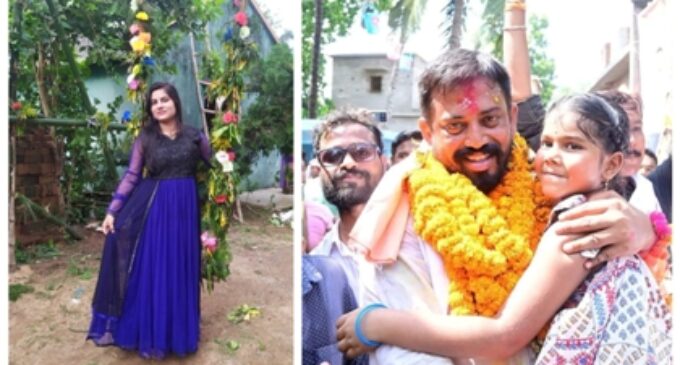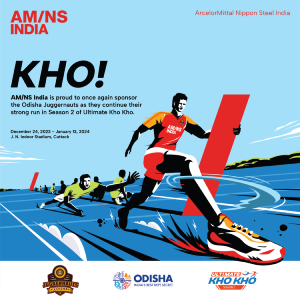RAJA THE FESTIVAL OF MONSOON REVIVED THE AGE OLD RURAL SPORTS IN JAJPUR

By Akshya Rout
JAJPUR, JUN 15 : The age -old martial arts and other rural sports which were almost a traditional hallmark of Raja, Dussera, Kali Puja, Ratha Jatra. and other festivals ,seem to be dying a slow death in Jajpur district and its nearby areas.
The ever increasing reach and popularity of cable television also plays a role in this. But in village Khanditara , Balichandrapur, Chatia, bari ,Dharmasala,Badachana and other villagers organised the three day long Raja festival where many villagers exhibit their traditional martial and other sports . Many villagers used to practise wrestling , sword fighting, paika akhada, Bagudi , horse dance and Kabadi in earlier times.
But presently, this is rarely done as the younger generation lacks its rudimentary knowledge and is lured away by the television, preferring to watch sports rather than take part in these events for which the village committee members of Bagada have been organizing ancient sports including martial arts to revive the art forms.
The three day long martial sports attracted thousands of people on the occasion of Raja festival “Raja festival is also called as monsoon festival as the farmers start cultivation after the Raja festival.
Each year monsoon generally reach Orissa in the first week of June. But the delay of the arrival of monsoon this year dampened the sprit of Raja, the festival of monsoon in many areas of state. But the villagers celebrated the Raja festival by organizing rural sports”, Said Former Minster Prafulla Chandra Ghadei.
He Said Raja Festival: A quintessential Odia festival, Raja is a 3-day festival celebrated every year in the month of Asadha (2nd week of June). Fun, frolic, mouth-watering food, and new clothes amidst the first showers of monsoon describe Raja. Raja is celebrated with great enthusiasm in Odisha, but children and adults alike. Raja is celebrated for 3 days in June-mid, from 14th-16th June.
The extreme heat of the months before it is calmed down in June with the advent of the South-West Monsoon, which brings with it the festival of jubilation and celebration. Raja has deep significance for the primarily agricultural community of Odisha, as it is believed to bring rainfall and hence irrigation for their crops.
Raja is an important festival, especially in today’s times, as it celebrates womanhood and the menstrual cycle. The word Raja is derived from Rajaswala, meaning menstruation. The festival has contributed to raising awareness about the menstrual cycle and accepting it throughout the ages.
It is believed that Mother Earth herself is “menstruating” during these 3 days, and hence no agricultural activities like tilling, sowing, or construction are carried out during this period of time. Young girls are pampered by their parents, given sweet treats to eat, new dresses to wear, and allowed to play and make merry all day long.
After 3 days of celebration, Mother Earth is symbolically given a bath called Basumati Gaadhua and then prayed for a prosperous agricultural year ahead. Raja is observed for 3 days, primarily by young girls and womenfolk.
According to Writer Taraprasad Mishra, Women are given relief from their daily household chores like cooking, sweeping, cleaning, etc.
Young girls bedeck themselves with beautiful ornaments and new clothes on the occasion of Raja. Women are pampered by their families during this auspicious time with varied sweets like Poda Pitha, Arisa Pitha, Kakra Pitha, Sara Puli, Chhena Poda, Chhena Puli, Saru Chakuli, and a variety of other traditional Odia sweets.
A popular gift for girls is a pair of anklets made out of silver, as well as other ornaments. Women play cards and make merry together for the 3 days that are celebrated as Pahili Raja, Raja Sankranti, and Sesa Raja.
An important Raja ritual is the building of swings for young girls everywhere, whether it is outdoors or just outside the house. Girls and young women play on these swings and enjoy the days which are dedicated to them.and “We organised competitions for Kabadi, Bagudi and wrestling ,sword-fighting and other traditional martial arts to encourage youth participation for three day long Raja festival”.
Around70 youths of seven blocks of the district participated in Kabadi , Bagudi, sword-fighting and other rural sports and the events drew thousands of spectators. The craze of cricket for the youths is the main reason behind the untimely death of many rural sports in the state.According to renowned Writer Rachita Mishra of that many interesting legends surround the origin of the arts here.
To defend Hindu religion during the Mogul rule, many persons learnt martial arts to fight the Muslim invaders is one of the legends. These martial art practices have percolated down the generations through family patronage. There popularity is on a wane, but for the efforts of village committee of Bagada and Itipur who are trying for their revival.
It is high time these unique art forms patronised by the government. But the district administration has been paying only lip service towards the age old art forms, said Prakash Mallik a sword-fighter of Balichandrapu On This Occasion Newly elected Dharmasala MLA Himanshu Sekhar On Friday attend The Raja Fesival at Ratanpur In Jajpur district.
He Said “Greetings on the very special festival of Raja Parba. May this occasion strengthen the spirit of joy and brotherhood in society. I also pray for the good health and well-being of my fellow citizens”






